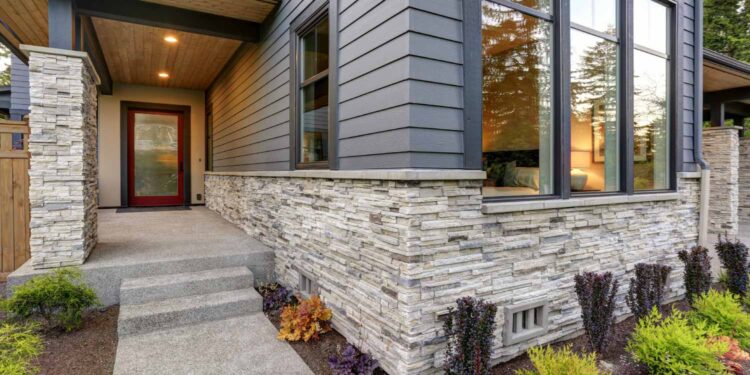Delving into the realm of tile siding exterior, this article aims to shed light on the beauty and functionality it brings to your home. From enhancing curb appeal to providing lasting protection, tile siding is a versatile choice for exterior applications.
Let's uncover the wonders of tile siding together.
.
Overview of Tile Siding Exterior
Tile siding exterior is a type of cladding material used on the exterior walls of buildings to provide protection and aesthetic appeal. It consists of individual tiles made from various materials that are installed in an overlapping pattern to create a weather-resistant barrier. One of the primary purposes of tile siding is to enhance the curb appeal of a structure while also offering protection against the elements. It helps to shield the underlying structure from moisture, wind, and other environmental factors, extending the lifespan of the building.Benefits of Using Tile Siding for Exterior Applications
- Enhanced Durability: Tile siding is known for its longevity and resistance to rot, insects, and fire, making it a durable choice for exterior cladding.
- Aesthetic Variety: With a wide range of materials, colors, and textures available, tile siding allows for customization to suit different architectural styles and preferences.
- Low Maintenance: Once installed, tile siding requires minimal upkeep, typically only needing occasional cleaning to maintain its appearance.
- Energy Efficiency: Certain types of tile siding can help improve the insulation of a building, leading to energy savings and increased comfort indoors.
Common Materials Used for Tile Siding Exteriors
- Ceramic: Durable and versatile, ceramic tiles are a popular choice for tile siding exteriors due to their resistance to moisture and ability to retain color.
- Natural Stone: Providing a timeless and elegant look, natural stone tiles offer durability and a unique aesthetic appeal to exterior walls.
- Fiber Cement: Made from a mixture of cement, sand, and cellulose fibers, fiber cement tiles are lightweight, durable, and resistant to fire and pests.
- Vinyl: Affordable and low-maintenance, vinyl tiles are a cost-effective option for tile siding exteriors, available in a variety of colors and styles.
Types of Tile Siding
When it comes to tile siding for exteriors, there are various materials to choose from, each with its own unique characteristics and benefits.Ceramic Tile Siding
Ceramic tile siding is a popular choice known for its durability and versatility. It can be customized in different colors, shapes, and patterns to achieve a variety of looks. Ceramic tile siding is resistant to fire, moisture, and pests, making it a long-lasting option for exterior cladding.Natural Stone Tile Siding
Natural stone tile siding, such as granite or marble, offers a luxurious and elegant appearance to any home exterior. While it is more expensive than other options, natural stone is extremely durable and can withstand harsh weather conditions. It adds a timeless and sophisticated look to the facade of a house.Faux Wood Tile Siding
Faux wood tile siding provides the aesthetic appeal of real wood without the maintenance requirements. This type of siding is made from durable materials like fiber cement or vinyl, offering excellent moisture resistance and protection against rot and pests. Faux wood tile siding is available in a wide range of colors and textures to mimic different wood species.Concrete Tile Siding
Concrete tile siding is a cost-effective and low-maintenance option for exterior cladding. It is highly durable and can withstand extreme weather conditions, making it a popular choice for homes in areas prone to hurricanes or high winds. Concrete tile siding is available in various styles and finishes, including smooth, textured, or stamped patterns.Overall, the choice of tile siding material will depend on the desired aesthetic, budget, and maintenance preferences of the homeowner. Each type offers unique advantages in terms of durability, appearance, and customization options for exterior designInstallation Process
When it comes to installing tile siding on an exterior surface, there are several important steps to follow to ensure a successful and long-lasting result.Preparation
Before beginning the installation process, it is crucial to prepare the exterior surface properly. This includes cleaning the surface thoroughly to remove any dirt, debris, or old paint that may prevent the tiles from adhering properly.Tools and Materials
In addition to the tile siding material itself, you will need a few special tools to complete the installation process. These may include a saw for cutting the tiles to fit, a level to ensure they are installed straight, and a trowel for applying adhesive or mortar.Installation Steps
- Cut the tiles to fit the dimensions of the exterior surface, taking care to leave space for expansion and contraction.
- Apply adhesive or mortar to the back of each tile and press them firmly onto the surface, starting from the bottom and working your way up.
- Use a level to ensure each tile is installed straight and evenly spaced from the others.
- Allow the adhesive or mortar to dry completely before applying grout to fill in any gaps between the tiles.
- Seal the grout to protect it from moisture and ensure the longevity of the installation.
Maintenance and Care
Proper maintenance of tile siding exteriors is crucial to ensure their longevity and appearance. By following some simple care tips and addressing common issues promptly, you can preserve the beauty of your tile siding for years to come.Common Maintenance Issues and Solutions
- Regular Inspection: Conduct regular visual inspections of your tile siding to check for any cracks, chips, or loose tiles. Addressing these issues promptly can prevent further damage.
- Sealing: Properly seal your tile siding to protect it from moisture and harsh weather conditions. This will help prevent mold and mildew growth.
- Repairs: If you notice any damage to your tile siding, such as cracks or loose tiles, make sure to repair them immediately. This will prevent water infiltration and further damage.
Cleaning and Preservation Tips
- Regular Cleaning: Clean your tile siding regularly with a mild detergent and water to remove dirt, grime, and debris. Avoid using harsh chemicals that can damage the tiles.
- Mildew Prevention: To prevent mildew growth, ensure proper ventilation around your tile siding and trim any overhanging trees or bushes that may block sunlight and airflow.
- Stain Removal: For stubborn stains, use a gentle cleanser or a mixture of vinegar and water. Avoid abrasive scrubbing that can scratch the tiles.













